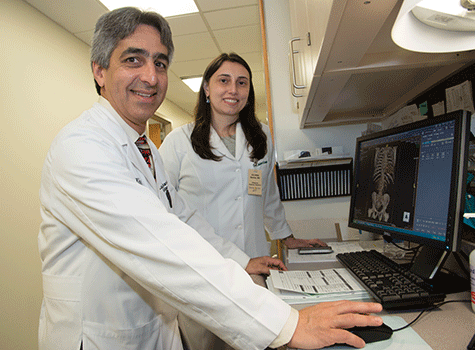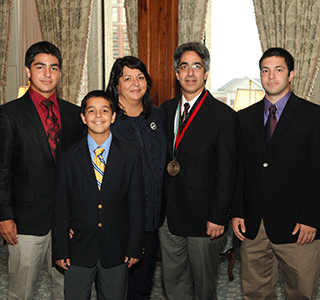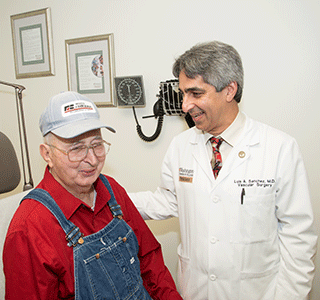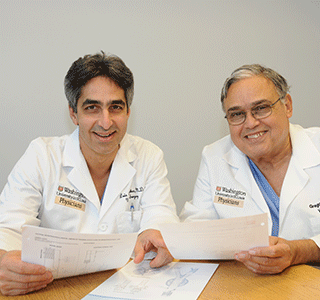
Luis Sanchez remembers tagging along with his father, a family physician, on home visits when he was a boy growing up in San Juan, Puerto Rico.
“I carried his bag when he went out to see patients,” said Sanchez, MD, the Gregorio A. Sicard Distinguished Professor of Vascular Surgery. “And people also lined up in front of the house to see him. They paid with whatever they had. Sometimes they brought food. There were no appointments. He saw whomever showed up until there were no more patients.”
During the day, his father directed one of San Juan’s public health units. And at night, he maintained a primary care practice. But despite his father’s dedication to the profession, he did not push his son to become a doctor.
“His hours were very long,” Sanchez said. “He told me a career in medicine involves a lot of sacrifice and that I should consider doing something else.”

(Credit: Courtesy of Sanchez family)
But surrounded by medicine as he was – his mother was a public health administrator who helped train nurses and others on issues of public health – perhaps it was inevitable that Sanchez would go into a medical field.
“Although my father died when I was only 7, I always kept his cautionary advice in mind,” Sanchez said. “Not until my second year of college did I decide that medicine is what fits me best.”
Today, Sanchez, chief of the section of vascular surgery at Washington University School of Medicine in St. Louis and Barnes-Jewish Hospital, is an internationally known vascular surgeon. He has helped advance and guide the field for the past 20 years.
Originally, though, Sanchez didn’t set out to be a vascular surgeon. As he was completing medical school at Harvard University, he hoped to find a good general surgery residency somewhere in the Northeast. He wanted to be close to his wife, Ilsa, who was finishing law school at Columbia University. Though both are from San Juan and attended rival high schools, they first met as undergraduates at Yale University.
They both ended up in New York City — with Luis Sanchez at the Montefiore Medical Center at the Albert Einstein College of Medicine. “And unbeknownst to me, it had a very strong program in vascular surgery,” he said.
Frank J. Veith, MD, then chief of vascular surgery at Montefiore and Albert Einstein, remains one of the best-known vascular surgeons in the world. He took Sanchez under his wing, involving him in research and asking Sanchez to fill in for him at international speaking engagements that he could not attend.
“These were wonderful opportunities to meet other leaders in vascular surgery,” Sanchez said.

(Credit: Robert Boston)
As he was completing his fellowship training in the early 1990s, there was great interest in developing less invasive ways to treat aneurysms — weak points in the wall of a blood vessel that balloon out, creating a bulge that can rupture without warning and quickly lead to death.
“As our patient population was living longer, we had a growing number of them with aneurysms and other problems that we couldn’t treat,” Sanchez said. “The standard open and invasive procedures available at the time were too risky.”
He calls his timing lucky because in the early 1990s, a surgeon in Argentina, Juan Parodi, MD, reported one of the first cases in which an aneurysm was treated with an endovascular approach — by going in through the blood vessels themselves via a small incision in the groin rather than opening the abdomen.
Veith and his colleagues at Montefiore invited Parodi to New York to demonstrate the new technique. And when the first endovascular repair of an aneurysm was performed in the United States in late 1992, Sanchez was in the room.
“Since this worked, it opened the door to the development of a whole new realm of less invasive treatments for patients,” Sanchez said. “The new developments began in the early 1990s, and they continue today.”
After his fellowship training, Sanchez spent five years on the faculty of the Albert Einstein College of Medicine as part of a team leading the way in less invasive vascular surgery techniques. In 1999, he moved to Washington University School of Medicine, after being recruited by Gregorio A. Sicard, MD, then chief of vascular surgery.
Washington University has become a leading center in the testing of new endovascular devices and the training of young surgeons in how to use them. Most recently, the field has introduced fenestrated stents, which have holes placed to accommodate the arteries branching off the main vessel so as not to block any blood flow.

“There has been growth in trying new things so that we can help patients we couldn’t treat before,” Sanchez said. “Washington University has continued to be part of that leading edge, testing and using new stent technology. We are the largest training center in the U.S. for fenestrated stents.”
Sanchez said he is most excited about what are referred to as “off-the-shelf” fenestrated stents. Until recently, fenestrated stents had to be custom-made for each patient.
“We take a CT scan, measure it and determine where we need holes so that when we put the stent inside the patient, the holes line up with their arteries,” Sanchez explained. “Unfortunately, these custom stents are only made in Perth, Australia – literally the other side of the world. It takes about four weeks for the stent to be made, sterilized and sent back to the U.S.”
Other options would be helpful, particularly in emergencies, when the patient can’t wait four weeks.
“With off-the-shelf devices, we can treat patients without delay if the stents fit the anatomy,” Sanchez said. “Potentially, we could even treat patients with ruptured aneurysms, which carry the highest risk.”
Sanchez is quick to point out that these interventions do not cure the disease.
“As we get older, the plumbing can go bad,” he said. “Many of these patients need lifelong management of their progressive vascular disease. So we end up building some significant relationships with our patients.”
And that, Sanchez said, is one of the things he likes best about his job – taking care of patients. A sentiment to which his father certainly would have related.